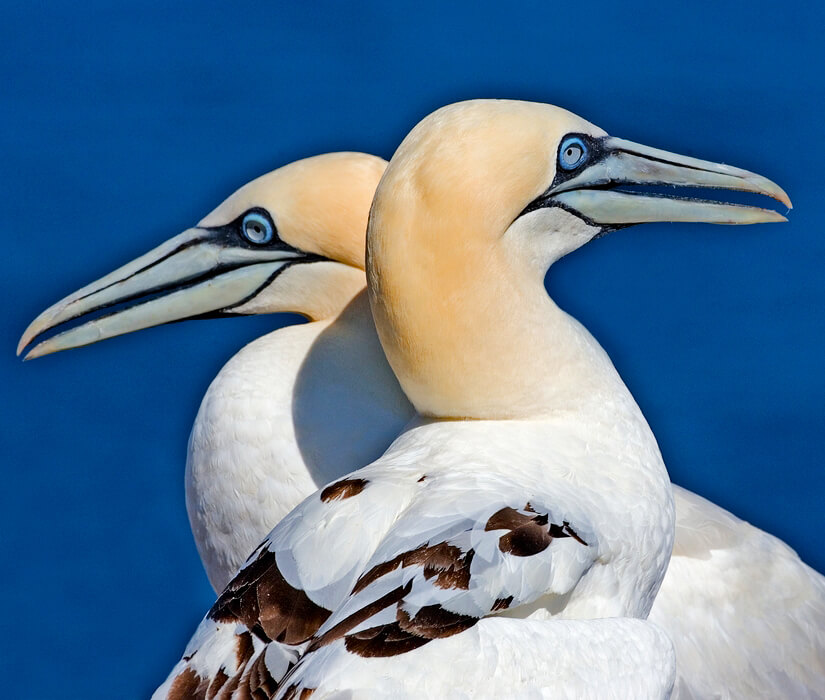First Global Review of Bycatch from Gillnet Fishing Puts Seabird Death Toll in Hundreds of Thousands
 |
| Northern Gannets are one of the birds that are killed in large numbers by gillnets. Photo by Alan Wilson. |
(Washington, D.C., June 6, 2013) A new study published in the journal Biological Conservation provides the first global review of seabird mortality associated with the gillnet fishing industry and finds that, at a minimum, 400,000 seabirds are killed accidentally in gillnets each year, with numerous species suffering potentially significant impacts.
The study documents 81 species that have been caught and killed in gillnets and another 67 species that are potential victims. The list of susceptible species includes five Critically Endangered, 14 Endangered, 29 Vulnerable, and 15 Near Threatened species, as classified by the International Union for Conservation of Nature. The highest bycatch has been reported in the Pacific Northwest (about 194,000 individuals), Iceland (around 100,000), and the Baltic Sea (around 76,000). However, the report said that it is almost certain that that the actual number of birds killed in gillnets worldwide is much higher because of numerous data gaps.
According to the report, “…gillnets have been the cause of some of the highest recorded mortalities of seabirds worldwide. The status of seabird populations is deteriorating faster compared to other bird groups, and bycatch in fisheries is identified as one of the principle causes of declines.”
The authors of the study are Ramunas Zydelis from DHI (an independent consulting group) and Cleo Small and Gemma French from the BirdLife International Global Seabird Program based at the Royal Society for the Protection of Birds.
Gillnet fishing uses a mesh net that may be anchored to the sea bottom or float in the water column with the top portion buoyed in some fashion, enabling the net to effectively become a wall that traps certain fish depending on the size of the mesh openings. These nets are indiscriminate; all marine life that cannot pass through or around them can become entangled and drown or become prey for other species. Industrial-scale fishing with drift gillnets longer than 2.5 kilometers was banned on the high seas by the United Nations in 1991 in part as a result of public outrage over the bycatch of marine mammals, seabirds, sea turtles, and non-target fish species. Nets that work the same way, albeit of far shorter length, are still in use in international waters and in commercial and local fisheries within the 200-mile Exclusive Economic Zones of many countries.
Auks or Alcids (members of the family Alcidae) — medium-sized diving seabirds that are restricted to the Northern Hemisphere — are the taxonomic group most frequently caught by gillnets, with significant impacts identified for colonies off the Atlantic coast of the Iberian Peninsula and islands in the Northwest Pacific. Notable impacts have also been identified for sea ducks in the Baltics, loons and other diving birds in the Northwest Atlantic, and penguins in the Southeast Pacific, Southwest Atlantic, and New Zealand.
The report says that no technological solutions are known that could universally mitigate the problem, in part because of the rather modest investment in research. Other issues include the large variety of gillnet configurations and the high diversity of target fish species and affected seabirds. The authors indicate that the most feasible way to mitigate the problem is through regulation of the fishing effort or through gear substitution. Such regulatory efforts were undertaken in California between 1980 and 2000 with dramatic results leading to a rebounding in the population of the Common Murre that had been suffering losses of about 10,000 birds per year.
Similarly, population-level impacts of seabird mortality in gillnets have been documented by Canadian scientists at Memorial University in Newfoundland. The study by Paul Regular and William Montevecchi and coworkers, published just subsequent to the Zydelis et al. global review, documents a significant rebound in numbers of diving species such as murres and gannets in the years since gillnet fisheries off Canada's east coast were closed in 1992. However, gillnets are among the most pervasive types of fishing gear, and although their industrial use may be regulated or banned in some parts of the globe, local or artisanal use of gillnets may require different solutions, including modifications to make them safer for birds.
“Gillnets currently pose among the greatest challenges in reducing seabird mortality in fisheries,” said Holly Freifeld, Seabird Program Director at American Bird Conservancy. “With our Peruvian partner ProDelphinus, we are developing and testing modified surface gillnets to reduce the risk to seabirds – particularly to the Waved Albatross, a Critically Endangered species endemic to the Galapagos Islands. Many thousands of small fishing boats in the Americas use a variety of gillnets, and these artisanal fisheries are largely unregulated. Simple gear modifications that maintain or improve fishermen's catch of their target fish while reducing the risk for seabirds have the potential to be adopted widely in these fisheries, grass-roots style. ProDelphinus's experiments are in early stages now, and we are currently focused on only one fishery and type of gillnet. But it's a start, and we are optimistic.”


















































